USA win 4th Women’s World Cup
The United States women won their fourth World Cup title, defeating the Netherlands to defend their crown in Lyon.
Entering the match, each of the two teams come from differing histories in relation to women’s football. For all of their folklore in men’s football, the Dutch have quite a recent history with success on the women’s side. 2015 was their first World Cup where they exited in the Round of 16, they won the most recent European Championships, and just recently qualified for their first Olympic Games.
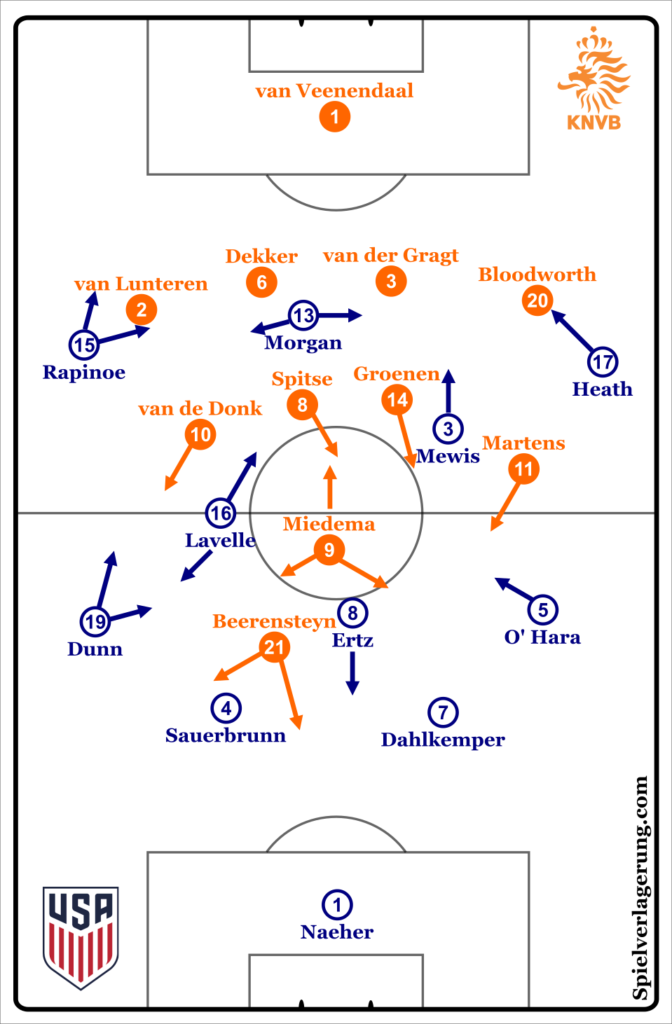
As of right now, the United States represent the highest standard in women’s football. With four Olympic gold medals, three World Cup titles entering the match, alongside a rich player pool and nationwide investment and social support, the Americans have possessed the best team when it comes to talent, depth, and quality of the athletes throughout the roster for the past few decades.
The major point is that prior to kickoff, the Netherlands had a tall order against them to be able to leave France with the trophy in hand. As a result, they adjusted their team selection in tactics in a few ways. From a selection point of view, the main change made was in the back, with Dekker chosen in place of van Dongen, pushing Bloodworth to left back. Their 4-3-3 was scraped in favor of a 4-4-1-1, to be expanded upon momentarily.
Jill Ellis made two shifts to her starting team, favoring Sam Mewis over Lindsay Horan, and reinserting the star of the tournament Megan Rapinoe over Press. There were little to no new tactical variations on display from the Americans in this final. If the system isn’t broken, don’t fix it.
Netherlands frustrate USA through compact defensive block
Given the challenge in front of them, the Netherlands had to formulate a strategy to neutralize the Americans and prevent them from running riot in attack as they had in past games, placing their opponents under duress from the opening stages. USA had scored in the first fifteen minutes of every game, and if they did so today, the uphill battle would steepen.
With this in mind, Sarina Weigman altered her team’s approach without possession. In this 4-4-1-1, the defensive line situated themselves roughly 10 meters past the centre circle, with distances of about 7 meters between each player horizontally. The midfield line mimicked this organization 10 meters ahead of them. Miedema operated as a number 10, positioned just behind Beerensteyn, who each dropped off the centre backs considerably and gladly ceded possession to them.
Considering a bulk of American goals had come from high speed counter attacks in the knockout stages after having a minority of possession, the Dutch attempted to stifle the Americans by turning the tables. By ceding possession, at the expense of territory at times, it forces USA to come up with solutions in possession with greater space restrictions than in open transition to get to goal. These situations pose greater difficulty and place a higher premium on ability in tight spaces and timing than sheer athletic ability or physical power.
For the Dutch, this strategy worked well to neutralize the Americans, and prompted numerous developments in the match that the Dutch were able to deal with.
First the United States subsequent movements in possession. Within their 4-3-3, Heath and Rapinoe moved high and wide early in possession, as Morgan most commonly started out right to move toward the left in order to link up with Rapinoe and Lavelle. Mewis and Lavelle occupied high lines relative to nearby players, frequently joining the attacking trio ahead of them in line, bolstering the presence closer to goal yet making the distances between players long at the expense of central connections. Mewis’ higher positioning indicated a focus on possibly winning aerial balls over playmaking.
Over time, Lavelle began to drop toward Dunn to get more of the ball in possession, yet this just elongated the distances between the first line and the forwards, creating an expansive structure without the necessary occupation for clean ball progression.
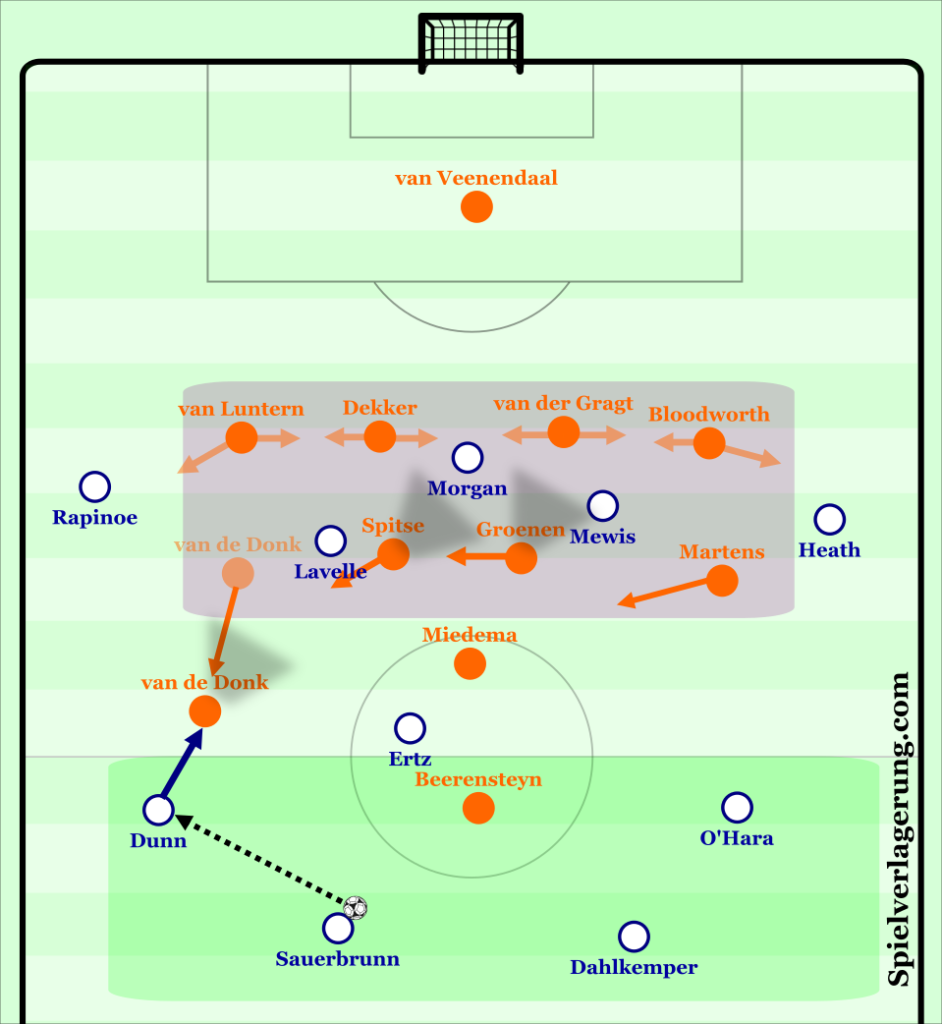
Given Ertz’ more defensive focus, she remained closer to her centre back partnership, typically between the duo the Netherlands left up the pitch to block central passing lanes. Because of the Netherlands central congestion and the deeper starting points of Martens and van de Donk, both O’Hara and Dunn were the outlets early in build up. They could each march forward with ball for 10-15 yards without substantial pressure. During this time, the Dutch midfield four shifted as the nearest player applied pressure, with the subsequent cover shielding closer passes into the center.
Yet because there were not shorter options available, fullbacks played more difficult longer passes forward that sparingly found their targets. In general, longer passes are harder to consistently complete and shorter connections, as they require more precision from the pass itself alongside the timing of the receiver. Many of these passes were played in behind the Dutch and went errant either because the passes had too much weight on them, the runs were not made in time, or a combination of both. With the Dutch forcing USA wide and away from the goal, they were able to control these situations.
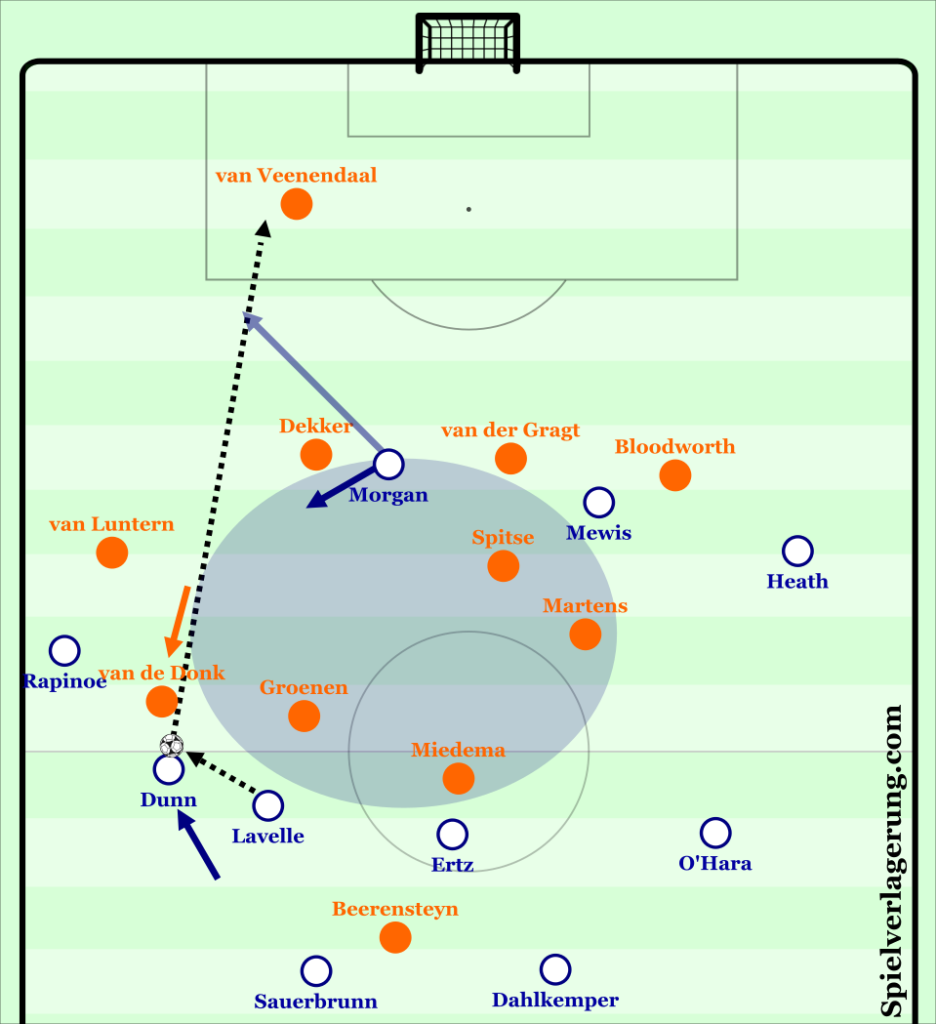
Some of these technical miscues lead to the Netherlands having to clear it wide since the American forwards placed pressure on the defensive line as they chased, leading to forward progress. Yet the most dangerous the USA looked was during set pieces and in the following, where they had a series of plays that showed promise in getting chances on goal, while also bringing about the collective chaos that comes with high numbers when the ball is in the penalty area.
Other flashes of promise arose from isolated individual duels involving Heath and Rapinoe, particularly after failed Netherlands attacks or set piece clearances. In either case, the supporting midfielders in defense which were typically close by in normal play were further away, allowing for more space for individual dribbles, in which the Netherlands forced each of them wide so the defense could delay them and be able to defend the subsequent crosses.
In aggregate, these crosses and long distance attempts in front of the Netherlands block were unsuccessful for the US, with a few chances that were very close to going in thanks to good saves from van Veenendaal. The situations that these chances came about though were difficult though because of the little amounts of space and number of Dutch defenders in the box, with goals in those situations having to be impeccably timed or deflected. With closer central connections, the quality and quantity of American chances could’ve visibly improved considering the Dutch began to retreat further into their half as halftime beckoned.
With a high amount of defensive possession and struggles to involve Alex Morgan, Lavelle, and Rapinoe, the Netherlands succeeded in their task of preventing the Americans from scoring early and thus having the USA control the state of the game.
Auspicious Dutch counter attacks
While the Netherlands did not have much success in managing shots onto Naeher, there were several moments in which the US appeared under some duress as Dutch counter attacks began their formation. Once the Dutch won the ball, they hoped to use the creativity of Miedema as the 10 and the pace of Beerensteyn as the 9 to generate chances, with the midfielders operate in support.
Due to the US’s shape in possession, Beerensteyn had large gaps to run into between the central defenders, while the higher positioning of either Lavelle or Mewis provided space for the Dutch midfield to run forward as support, at times creating 4v5 situations which posed danger with the amount of space able to attack. Through closer positioning among the midfield three in these central areas, counterpressing for the US would have been aided. Lavelle in particular had some excellent moments against England with respect to this phase of the game, yet the space at times was too large for her efforts to succeed. The backline of the United States dealt with these threats very well, doing a wonderful job of forcing dribbles wide, although not without having the Netherlands move toward goal and get some hope through set pieces.
Miedema demonstrated some instances of strong individual dribbling to create these chances for herself and others, alongside well weighted passes. There were a few issues with the Dutch counters as the half wore on though, particularly in relation to Miedema’s positioning. As the half wore on, Miedema’s location relative to her midfield compatriots began to be farther and farther away as defensive pressure mounted and the Dutch retreated deeper. This meant once they won the ball, more responsibility fell on her shoulders in hold up play and keeping possession, despite being outnumber 3v1 at times. Consequently, possessions became shorter for the Netherlands, with the ball coming back toward their defense immediately after it had left.
The Netherlands were successful in their main objective for a long time, which was to keep the Americans scoreless. In fact, there are a lot of strategical similarities to Bert van Marwijk’s approach that was used against Spain in the 2010 World Cup Final. They were waiting for their chance to take the lead to come from these situations. Unlike the men in 2010 that had that Arjen Robben opportunity to give them the lead in minute 62, the women never had that chance because of a penalty kick at minute 61.
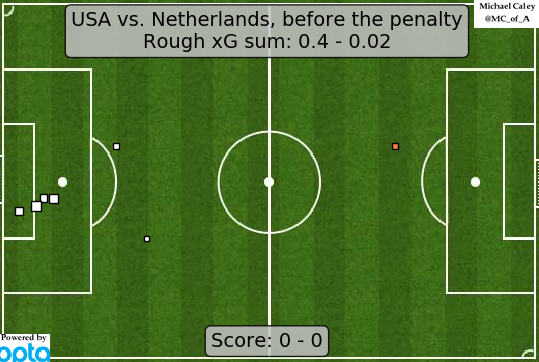
VAR Penalty alters Game State – USA pull away as Netherlands chase
The awarding and subsequent conversion of the VAR penalty kick by Megan Rapinoe led to a fundamental shift in the Netherlands’ strategy in minute 61. If they continued their approach, the US could hold the ball until the final whistle, prompting the Netherlands to apply more pressure and push more players higher in possession. They moved to 4-2-3-1, placing more of a vertical emphasis on their passes and thus opened the game because the rhythm had shifted from a slower paced ordeal to higher pace almost instantly.
This pace shift strongly benefitted the United States, the team with the speed advantage and superior athletes. For the first time in the match, USA could put Lavelle and Rapinoe on the ball with space to run in the middle during transitions, with the ability to play their teammates into space as opposed to tight central gaps that were congested with Dutch players earlier in the match. These situations are when the Americans were at their best all tournament, and they now had a plethora of these situations to work with.
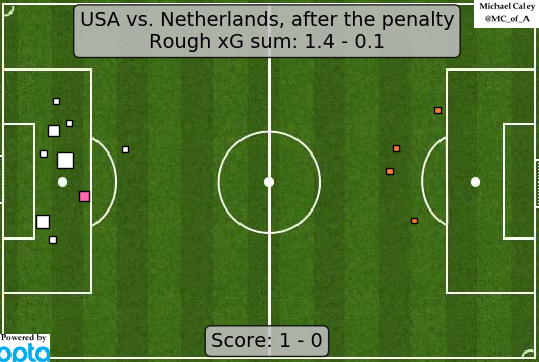
Eight minutes after Rapinoe’s first, Lavelle consummately finished a shot from just outside the box to double the lead. With twenty minutes remaining, the Dutch kept pushing for their chance to narrow the margin, with the USA countering the other way and hinting at a third frequently. This up and down ordeal continued to the final whistle, with the scoreline unchanged.
Conclusion
Goliath beat David. This result does not come as a huge surprise given the United States’ various advantages over the Netherlands. Yet the Netherlands kept it close for nearly an hour and deserve plaudits for maintaining a clean sheet as long as they did.
As an American, it is tough to discuss the women’s national team without discussing the various political and social topics that come with them and what they stand for. It is not Spielverlagerung’s mission to create a forum on said topics.
However, it is clear the paradigm on women’s football is starting to shift. Countries that are historically prominent in the men’s game are anteing up and investing more into their women than ever before, and this pattern is continuing onto the club circuit. Both matches against France and England for the US were tight thrillers. It shows the US spirit and mentality that they were able to come away with the win in those games. It also shows that the bar that the US set is starting to be met by the likes of France and England.
The thing about raising the bar is that one day someone else is going to hit that bar and surpass it. With financial and public support for the women’s game starting to grow from Europe’s top clubs (who have much more resources to play with than American women’s clubs), the US will have to continue to move forward and innovate as the rest of the world vies for what the United States has.
The target on the US back has grown in size with this victory, and if they want to threepeat come 2023, they will have to innovate as well to establish themselves as one of the best teams of all time.


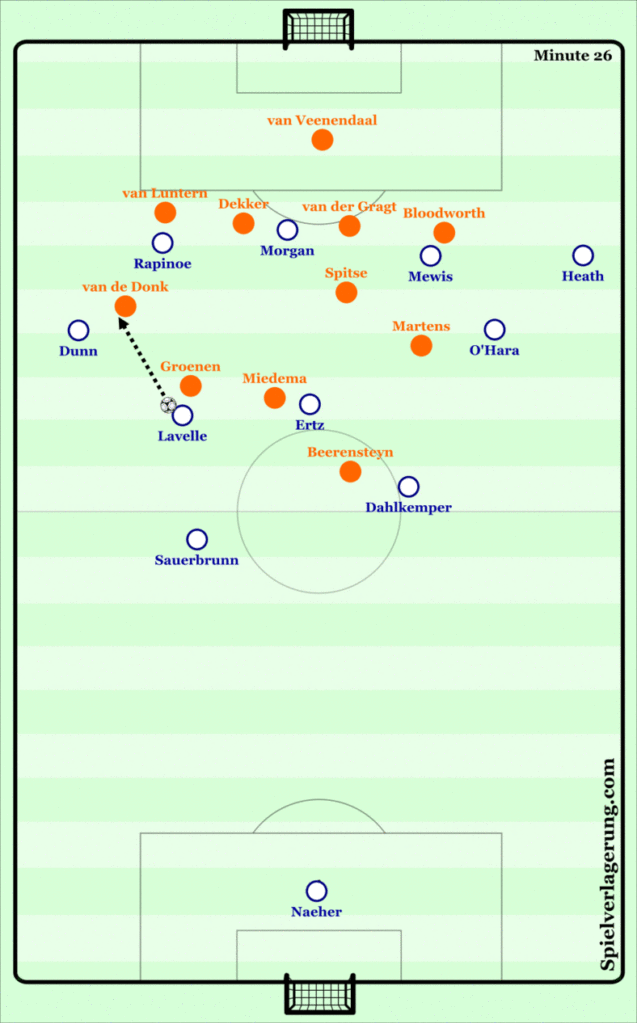
1 Kommentar Alle anzeigen
V.S. July 9, 2019 um 12:49 pm
Thanks for the writeup. I couldn’t see the game, so it was good to get an overview. I agree with your closing points, about traditional soccer nations stepping up their effort in the women’s game. I think the gap between the USA and the rest is not very big and can be closed in four years.
I saw all the goals of the tournament. Even in the knockout games there seemed to be a lot of goals from crosses. The Dutch goal against Sweden well-worked though: a defender is pulled out of position, an offensive player drives into the gap. If the Dutch can pull something like that off now, look out for what they (and others) will be doing in four years.